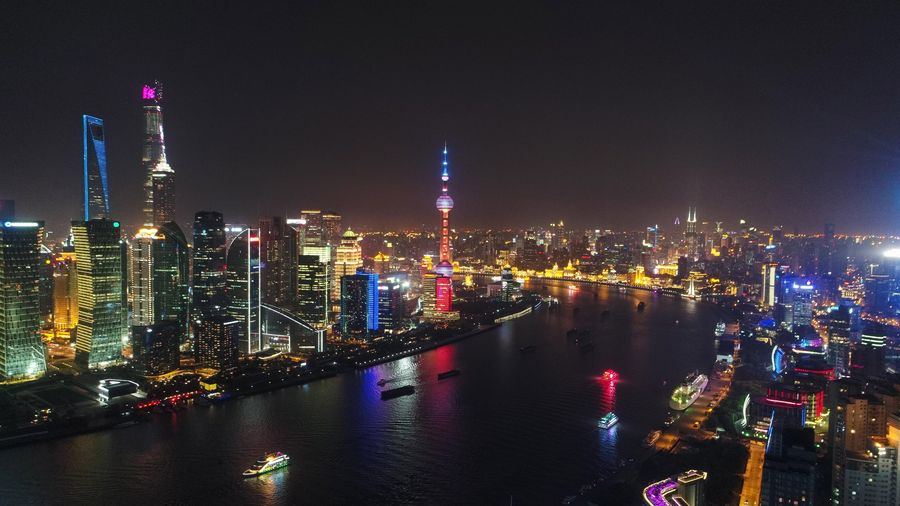
The night view of Lujiazui area in Shanghai, east China, May 14, 2017. (Xinhua/Ding Ting)
"Lifting 700 million people out of poverty since reform and opening-up really is an impressive feature. This has had impacts globally in terms of economy and in terms of moving not just China, but the world to middle-class status, which is important because it leads to political and economic stability," a U.S. scholar said.
HOUSTON, Sept. 13 (Xinhua) -- China has made a true leap in its economy and self-development in the past 70 years, a U.S. scholar has said in a recent interview with Xinhua.
The changes that have taken place in China are phenomenal and unprecedented in global history, said Jon R. Taylor, political science professor and department chair at the University of Texas at San Antonio.
"Lifting 700 million people out of poverty since reform and opening-up really is an impressive feature. This has had impacts globally in terms of economy and in terms of moving not just China, but the world to middle-class status, which is important because it leads to political and economic stability," he said.
With the world's largest population, China has been boosting its economic development on one major theme: improving people's livelihoods. This has become a fundamental goal and a consistent priority in policy-making.
According to figures released by the Chinese government, more than 700 million Chinese people have been lifted out of poverty over the past 40 years. The country's proportion of people living below the Chinese poverty line fell from 97.5 percent in 1978 to 3.1 percent among the rural population at the end of 2017.

A resettlement site in Yecheng County in Kashgar, northwest China's Xinjiang Uygur Autonomous Region, Aug. 19, 2019. (Xinhua/Ding Lei)
"We can talk all day, and you can debate the numbers. But to lift that many people out of poverty in a relatively short period of time is phenomenal," he commented.
Focusing his research on China for more than 20 years, Taylor pointed out that China has met most of its Millennium Development Goals (MDGs).
The MDGs, agreed by 189 UN member states in 2000, quantified eight targets, ranging from poverty eradication, women empowerment, child mortality reduction to combating AIDS and global partnership development, to address the needs of the world's poorest.
By helping the international community to achieve the target of halving the poor population, China continued to grow its development strategy. Even though there can be modifications to national and local characteristics, the China Model is impressive and provides examples for others to follow, he said.
"If you are emphasizing rapid economic growth, starting with labor intensive manufacturing, the China Model has been copied and continues to be copied, from Bangladesh and Pakistan to Kenya, from Tanzania to the west coast of Africa," Taylor said.
He also noted that China's growth and development is "unprecedented" in terms of increasing urbanization from around 10 percent in 1949 to over 50 percent today.

An urban area of Yunyang County, southwest China's Chongqing Municipality, July 30, 2019. (Xinhua/Wang Quanchao)
"Speaking of urbanization, we are talking about improving mortality rates both for individuals but also for children... about greater access to healthcare, to education, to transportation and infrastructure," he added.
Beside economic development, China has also made great achievements in education and technology, said Taylor.
"The radical and rapid expansion of higher education is linked to science, technology, and development goals. When you have Chinese universities ranked in the top 50 worldwide for research, that tells you something where China is," he said.

A whale sculpture made of plastic waste is displayed during the preview of the 2019 World Artificial Intelligence Conference in east China's Shanghai, Aug. 26, 2019. (Xinhua/Fang Zhe)
"China is the leader in AI and smart technology. It is now a focus of the Chinese government for high-tech development and education," said Taylor.
"I can only imagine 20 years from now, how insane it is going to be in terms of the amount of people, the growth, and the development," he said.
The professor recalled that when he went to China for the first time in 1996, there was not even a direct flight between Houston and Beijing. He had to make three airline connections from Oklahoma City to Beijing.
"Now it is a different Beijing, obviously much different," he said, adding that the new Daxing airport is opening in September, and Jingjinji mega region is being created.
This year marks the 70th anniversary of the founding of the People's Republic of China. Witnessing the changes over the last four decades in China, Taylor believes although the country became more advanced, its people have never changed.
"It's still the same people. They are still wonderful, friendly, curious people," he added.■



